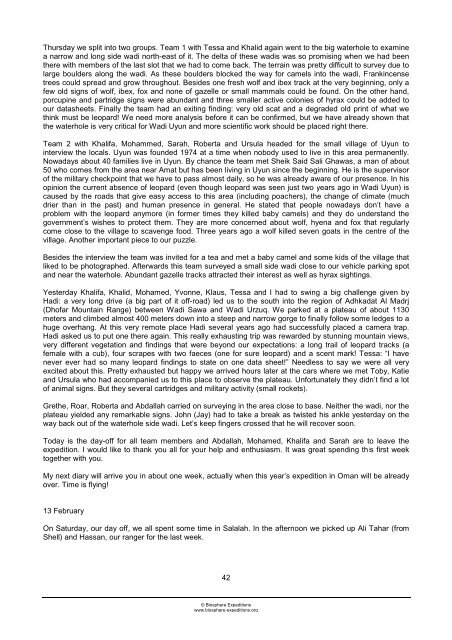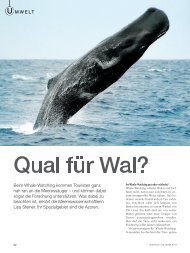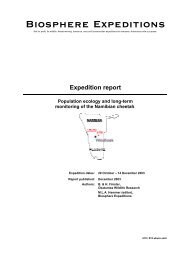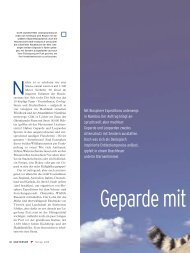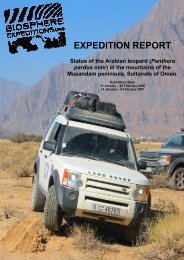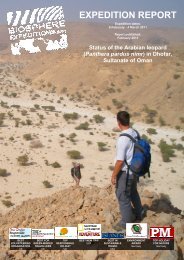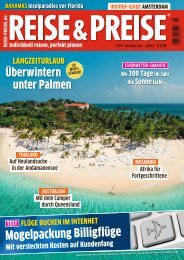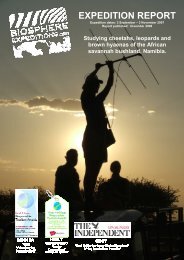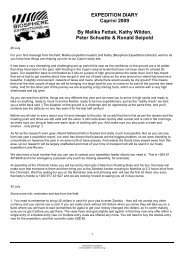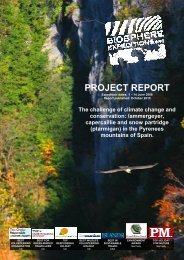EXPEDITION REPORT - Biosphere Expeditions
EXPEDITION REPORT - Biosphere Expeditions
EXPEDITION REPORT - Biosphere Expeditions
You also want an ePaper? Increase the reach of your titles
YUMPU automatically turns print PDFs into web optimized ePapers that Google loves.
Thursday we split into two groups. Team 1 with Tessa and Khalid again went to the big waterhole to examine<br />
a narrow and long side wadi north-east of it. The delta of these wadis was so promising when we had been<br />
there with members of the last slot that we had to come back. The terrain was pretty difficult to survey due to<br />
large boulders along the wadi. As these boulders blocked the way for camels into the wadi, Frankincense<br />
trees could spread and grow throughout. Besides one fresh wolf and ibex track at the very beginning, only a<br />
few old signs of wolf, ibex, fox and none of gazelle or small mammals could be found. On the other hand,<br />
porcupine and partridge signs were abundant and three smaller active colonies of hyrax could be added to<br />
our datasheets. Finally the team had an exiting finding: very old scat and a degraded old print of what we<br />
think must be leopard! We need more analysis before it can be confirmed, but we have already shown that<br />
the waterhole is very critical for Wadi Uyun and more scientific work should be placed right there.<br />
Team 2 with Khalifa, Mohammed, Sarah, Roberta and Ursula headed for the small village of Uyun to<br />
interview the locals. Uyun was founded 1974 at a time when nobody used to live in this area permanently.<br />
Nowadays about 40 families live in Uyun. By chance the team met Sheik Said Sali Ghawas, a man of about<br />
50 who comes from the area near Amat but has been living in Uyun since the beginning. He is the supervisor<br />
of the military checkpoint that we have to pass almost daily, so he was already aware of our presence. In his<br />
opinion the current absence of leopard (even though leopard was seen just two years ago in Wadi Uyun) is<br />
caused by the roads that give easy access to this area (including poachers), the change of climate (much<br />
drier than in the past) and human presence in general. He stated that people nowadays don’t have a<br />
problem with the leopard anymore (in former times they killed baby camels) and they do understand the<br />
government’s wishes to protect them. They are more concerned about wolf, hyena and fox that regularly<br />
come close to the village to scavenge food. Three years ago a wolf killed seven goats in the centre of the<br />
village. Another important piece to our puzzle.<br />
Besides the interview the team was invited for a tea and met a baby camel and some kids of the village that<br />
liked to be photographed. Afterwards this team surveyed a small side wadi close to our vehicle parking spot<br />
and near the waterhole. Abundant gazelle tracks attracted their interest as well as hyrax sightings.<br />
Yesterday Khalifa, Khalid, Mohamed, Yvonne, Klaus, Tessa and I had to swing a big challenge given by<br />
Hadi: a very long drive (a big part of it off-road) led us to the south into the region of Adhkadat Al Madrj<br />
(Dhofar Mountain Range) between Wadi Sawa and Wadi Urzuq. We parked at a plateau of about 1130<br />
meters and climbed almost 400 meters down into a steep and narrow gorge to finally follow some ledges to a<br />
huge overhang. At this very remote place Hadi several years ago had successfully placed a camera trap.<br />
Hadi asked us to put one there again. This really exhausting trip was rewarded by stunning mountain views,<br />
very different vegetation and findings that were beyond our expectations: a long trail of leopard tracks (a<br />
female with a cub), four scrapes with two faeces (one for sure leopard) and a scent mark! Tessa: “I have<br />
never ever had so many leopard findings to state on one data sheet!” Needless to say we were all very<br />
excited about this. Pretty exhausted but happy we arrived hours later at the cars where we met Toby, Katie<br />
and Ursula who had accompanied us to this place to observe the plateau. Unfortunately they didn’t find a lot<br />
of animal signs. But they several cartridges and military activity (small rockets).<br />
Grethe, Roar, Roberta and Abdallah carried on surveying in the area close to base. Neither the wadi, nor the<br />
plateau yielded any remarkable signs. John (Jay) had to take a break as twisted his ankle yesterday on the<br />
way back out of the waterhole side wadi. Let’s keep fingers crossed that he will recover soon.<br />
Today is the day-off for all team members and Abdallah, Mohamed, Khalifa and Sarah are to leave the<br />
expedition. I would like to thank you all for your help and enthusiasm. It was great spending this first week<br />
together with you.<br />
My next diary will arrive you in about one week, actually when this year’s expedition in Oman will be already<br />
over. Time is flying!<br />
13 February<br />
On Saturday, our day off, we all spent some time in Salalah. In the afternoon we picked up Ali Tahar (from<br />
Shell) and Hassan, our ranger for the last week.<br />
42<br />
© <strong>Biosphere</strong> <strong>Expeditions</strong><br />
www.biosphere-expeditions.org


